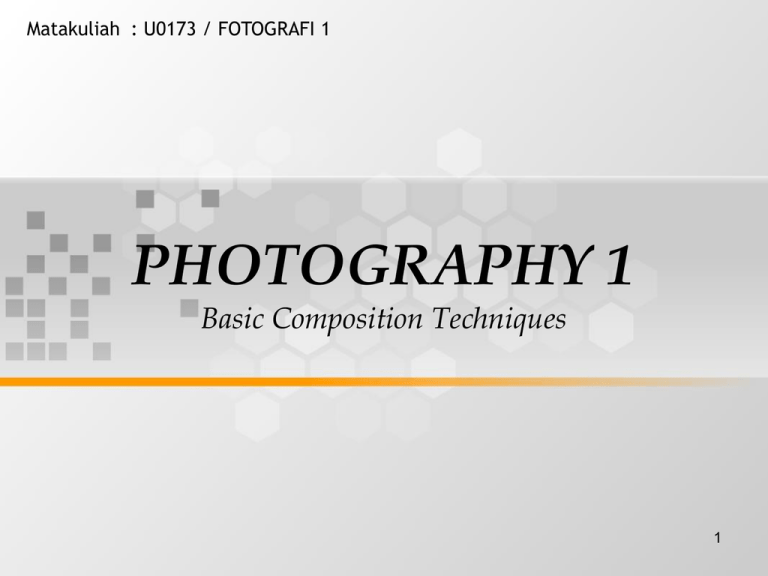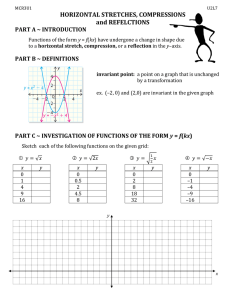PHOTOGRAPHY 1 Basic Composition Techniques Matakuliah : U0173 / FOTOGRAFI 1 1
advertisement

Matakuliah : U0173 / FOTOGRAFI 1 PHOTOGRAPHY 1 Basic Composition Techniques 1 In this session we will cover the following materials – – – – – Understanding the basic theory of composition in photography Using natural resources to help us in creating better composition and ultimately better pictures Playing around with horizontal & vertical composition Using different approaches such as negative spaces Using some external accessories to differentiate and create new effects for photography 2 Introduction • Now that we have taken our first photographs, let’s take a closer look at how we can further improve them • To be able to create better photographs , it is of course advisable to know what is wrong with our present ones 3 Guidelines and Questions Is the exposure right where we want them to be..? Is the pictures in focus ? (especially when there are moving objects involved) Do the pictures have foreground , middle ground and background in them ? Have we used them effectively Does our pictures seem rather boring when we look at it.? Do you feel that the pictures seems ordinary ? “At this point a second opinion from a fellow friend could also be useful” How are the colors coming out..? Is it the lab’s fault or ours ? 4 The Basic Theory of Composition There are 3 basic theories in composition in which we will learn them and eventually break them The Symmetrical Composition The Rule Of Thirds The Golden Rule 5 The Symmetrical Rule This is one rule that is usually embedded in a persons mind. (The norm of our mindset) Lets do a psychological exercise ! • All students take out their camera enabled mobile phone and take a picture of the person next to you • Next, show that person the picture you just took 6 A Symmetrical composition : 7 Example of : a Symmetrical composition 8 The Rule of Thirds This rule is much more complex as it requires us to imagine and use grids as a mean of measuring Imagine your frame is divided into 3 horizontal axis and 3 vertical axis. (you should get a frame with 9 boxes) The vertical axis should be the axis where you put out object / subject. The horizontal axis is places where you put your horizon lines. 9 The Rule of Thirds 10 Examples of Rule of Thirds using the vertical axis 11 Examples of Rule of Thirds using the vertical axis 12 Examples of Rule of Thirds using the horizontal axis 13 The Golden Rule The Golden Rule is a more simple approach in composition such as this rule will apply the more basic composition of the symmetrical rule and moving it a little to create a sense of unbalance In theory we would divide our picture frame equally in 2 as we would with symmetrical composition. But.. We will divide the other half of the frame into 3 parts. Our subject would late be placed in the first of the 3 lines nearest to the center of the picture. 14 The Golden Rule 15 Examples of : The Golden Rule 16 The Techniques Of Seeing Exploring Various Angles : • Eye Level - our eye • Birds Eye Level - higher • Cat’s Eye Level - lower Exploring different position : • Horizontal position • Vertical position • Observation for : repetitions, shapes, lines, colors, textures. 17 Using Horizontal vs Vertical Composition This is a common mistakes of beginning photographers to underestimate the ability to create great photographs just by turning the camera 90 degrees. It is also common practices that our mindset will automatically frame landscape images horizontally while portrait Images vertically. In this exercise we will show you the alternatives in which we could compose our pictures in ways other than the standard mindset. 18 Horizontal Composition 19 Vertical Composition 20 Applying Natural Elements into our pictures Observation For – Horizontal ,Vertical & Diagonal Lines – Textures – Colors – Shapes – Patterns 21 Colors and Horizontal 22 Framing an object 23 Patterns 24 Colors & Repetitive Patterns 25 End of Session 26



